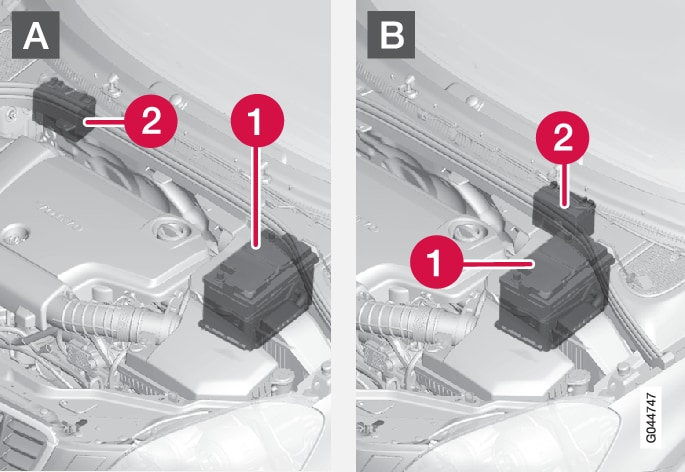For more information on Start/Stop - see Start/Stop.
For more information on the car's starter battery - see Jump starting with battery and Starter battery - specification.
Important
Note
- The higher the current take-off in the car (extra cooling/heating, etc.) the more the batteries must be charged = increased fuel consumption.
- When the capacity of the battery has fallen below the lowest permissible level then the Start/Stop function is disengaged.
Temporarily reduced Start/Stop function due to high current take-off means:
- The engine starts automatically4 without the driver depressing the clutch pedal (manual gearbox).
- The engine starts automatically without the driver lifting his/her foot off the foot brake pedal (automatic gearbox).
Location of the batteries

The support battery normally requires no more service than the normal starter battery. A workshop should be contacted in the event of questions or problems - an authorised Volvo workshop is recommended.
Important
If the following instruction is not observed then the Start/Stop function may temporarily cease to work after the connection of an external starter battery or battery charger:
- The negative battery terminal on the car's starter battery must never be used for connecting an external starter battery or battery charger - only the car chassis may be used as the grounding point.
See Jump starting with battery for a description of how the cable clamps must be attached.
Note
If the starter battery has become so discharged that everything is "black" and in principle the car does not have all the normal electrical functions and the engine is subsequently started using an external battery or battery charger, then the Start/Stop function will be activated. It will then be possible for the engine to be auto-stopped but in the event of an auto-stop the Start/Stop function may fail to auto-start the engine due to inadequate capacity in the starter battery.
The battery must first be charged in order to ensure a successful auto-start after an auto-stop. At an outside temperature of +15 °C the battery needs to be charged for at least 1 hour. At a lower outside temperature a charging time of 3-4 hours is recommended. The recommendation is that the battery is charged using an external battery charger.
If this is not possible then the recommendation is to temporarily deactivate the Start/Stop function until the starter battery has been adequately recharged.
For more information on charging the starter battery, see Starter battery.